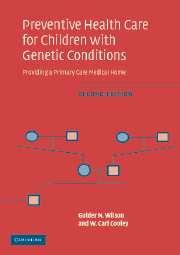Book contents
- Frontmatter
- Contents
- Preface
- Glossary of genetic and molecular terms
- Part I Approach to the child with special needs
- Part II The management of selected single congenital anomalies and associations
- 4 Congenital anomalies associated with developmental disability
- 5 Single anomalies, sequences, and associations
- 6 Teratogenic syndromes
- Part III Chromosomal syndromes
- Part IV Syndromes remarkable for altered growth
- Part V Management of craniofacial syndromes
- Part VI Management of connective tissue and integumentary syndromes
- Part VII The management of neurologic and neurodegenerative syndromes
- Part VIII Management of neurodegenerative metabolic disorders
- References
- Index
4 - Congenital anomalies associated with developmental disability
Published online by Cambridge University Press: 29 January 2010
- Frontmatter
- Contents
- Preface
- Glossary of genetic and molecular terms
- Part I Approach to the child with special needs
- Part II The management of selected single congenital anomalies and associations
- 4 Congenital anomalies associated with developmental disability
- 5 Single anomalies, sequences, and associations
- 6 Teratogenic syndromes
- Part III Chromosomal syndromes
- Part IV Syndromes remarkable for altered growth
- Part V Management of craniofacial syndromes
- Part VI Management of connective tissue and integumentary syndromes
- Part VII The management of neurologic and neurodegenerative syndromes
- Part VIII Management of neurodegenerative metabolic disorders
- References
- Index
Summary
Cerebral palsy and congenital brain defects
Terminology
Cerebral palsy embraces a range of conditions characterized by disordered movement or posture resulting from a non-progressive brain lesion or injury occurring prenatally or in early childhood (Palmer & Hoon, 1995). Cerebral palsy may be further defined by its topography (quadraplegia, hemiplegia, diplegia) or by its pathophysiology (pyramidal or extrapyramidal). Pyramidal lesions are associated with spastic types of cerebral palsy, while extrapyramidal insults are associated with hypotonic, choreoathetoid, and ataxic cerebral palsy.Overlap among the forms of cerebral palsy is common.
Cerebral dysgenesis refers to alterations in the formation of the central nervous system (CNS) (e.g., abnormal cellular migration or proliferation) resulting in congenital defects in the size, structure, and function of the brain.Most of these defects result in significant neurologic impairment, including cerebral palsy and mental retardation (Gabriel & McComb, 1985; Rosenbloom, 1995). For example, lissencephaly (smooth brain) or agyria is a disorder of neuronal migration associated with severe developmental consequences (Dobyns, 1987). Absence of the corpus callosum includes a spectrum of alterations in the formation of midline cortical structures with diverse etiologies and a wide range of developmental outcomes (Jeret et al., 1987). Porencephalic cysts result from a specific, destructive event such as a vascular accident in utero.
Historical diagnosis and management
Taxonomy and classification were of great interest to early clinicians resulting in much of the terminology still in use (Ingram, 1984).
- Type
- Chapter
- Information
- Preventive Health Care for Children with Genetic ConditionsProviding a Primary Care Medical Home, pp. 61 - 89Publisher: Cambridge University PressPrint publication year: 2006



